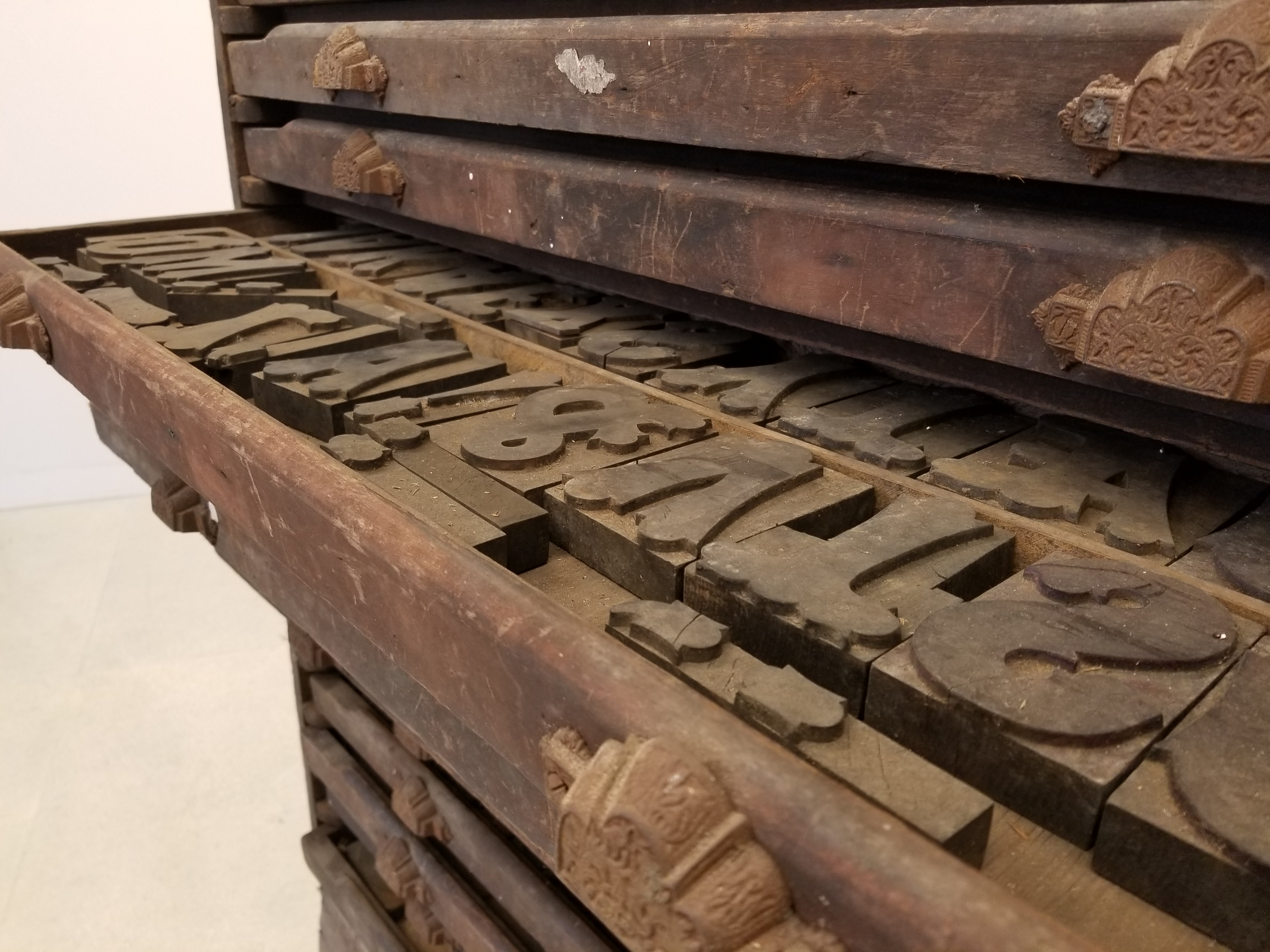
Loose lettering for the printing press (photos by: David Benedetto)
One of the more exciting artistic projects I’ve come across in the past few months is local non-profit Antenna’s Paper Machine Center and Print Shop, which will have an official grand opening next week. In anticipation for that event, I sat down with Antenna’s Executive Director Bob Snead and artist Christopher Deris (who designed the titular Paper Machine “sculptural apparatus” found inside the center) about the opening and what we can expect in the future from the print shop.
NolaVie: Bob, for our listeners that don’t really know what antenna is— would you mind describing it?
Bob Snead: Yeah! So Antenna is a 501(c) 3 non-profit originally founded in the Bywater, and we focus on visual and literary arts programming and encourage that programming all over the city. We provide grants and opportunities for artists and writers to do what they do in our city.
NolaVie: Fantastic. And what are some of the projects that fall under Antenna?
BS: We have our gallery space, which is on St. Claude in the Bywater. We have a residency program called Spillways that brings artists and writers from out of the city to develop projects here. We have a publication program called the Press Street Press, which was rooted in our founding— we’ve always done publication— and then the Draw-a-thon and Room 220.
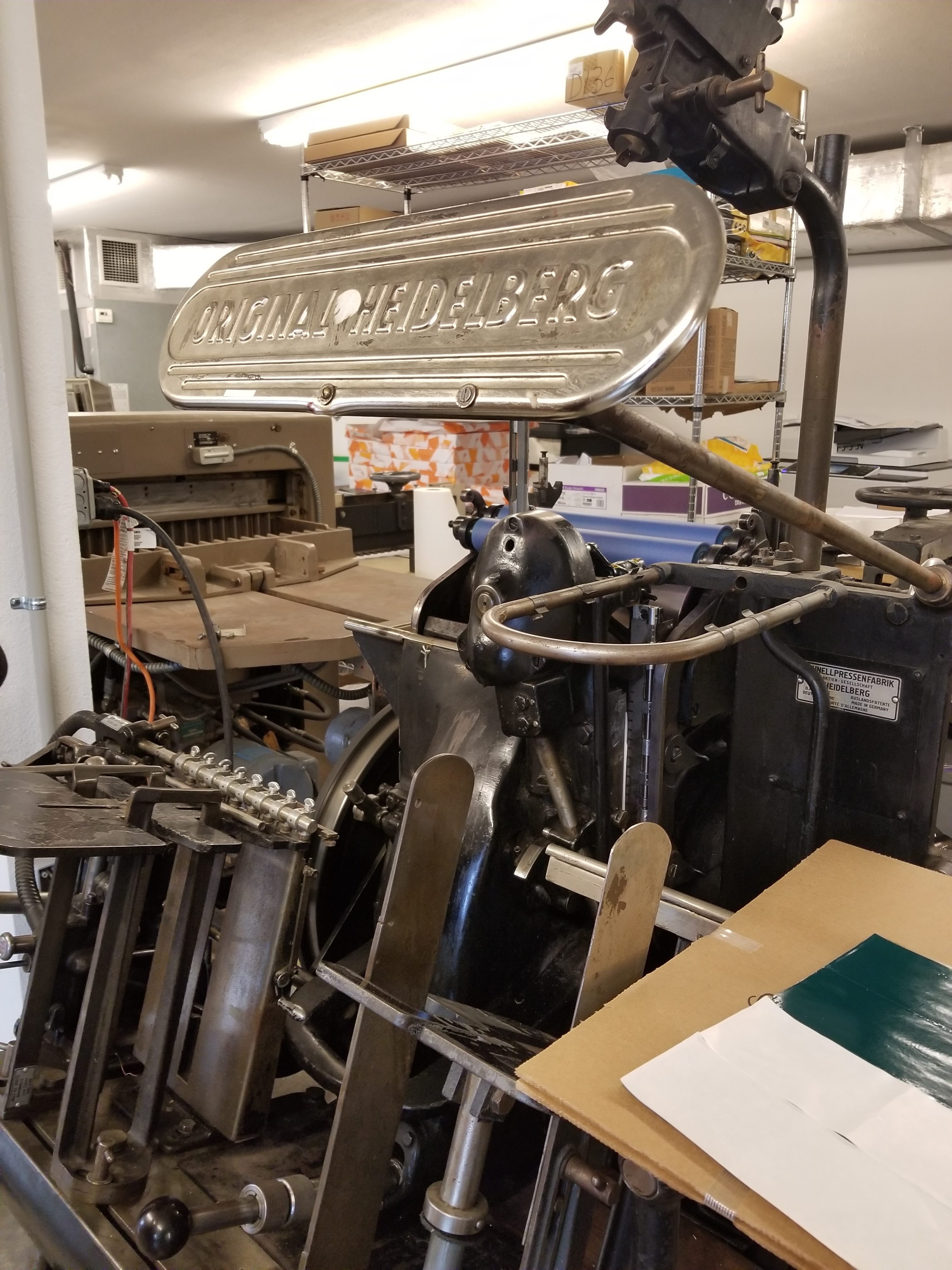
Printing press at Antenna (photos by: David Benedetto)
NolaVie: What I’m really excited to talk to you about is the Paper Machine Center and Print Shop that you just opened recently. I was wondering what was kind of the vision for that and how did it come about?
BS: During our founding— we’re almost 13 years old, this next year will be 13–and throughout that history we’ve been developing publications and have always been rooted in print in some capacity. And over the last two years we’ve really ramped up a lot of our public publications: producing open calls with artists and writers, focusing a lot of effort on artists and writers collaborations, [and] really getting obsessed with the kind of visceral quality of print. And we had this opportunity to take over a space in the Lower Ninth that’s actually owned by the same landlord as our current gallery space. And he gave us an amazing deal on the space— we have a five year lease, so we’ll be there for a while and then we’ll be able to have a purchase option to buy the building at the end of that.
And we were really excited about getting others in the visual and literary arts community excited about the possibilities of print and collaborating with other organizations and entities. So we’re working with Southern Letterpress and Jessica Peterson and then Gutwrench Press as well. They both house their facilities in this space. And then we also have studios for print-based artists— AnnieLaurie Erickson is one of our first artists to join us in that space. And then to get people really excited about the space and walking into it, we wanted to create this magical, whimsical printing apparatus that could exist in the front and that’s where Chriscame in and really took our harebrained scheme and made it this beautiful object.
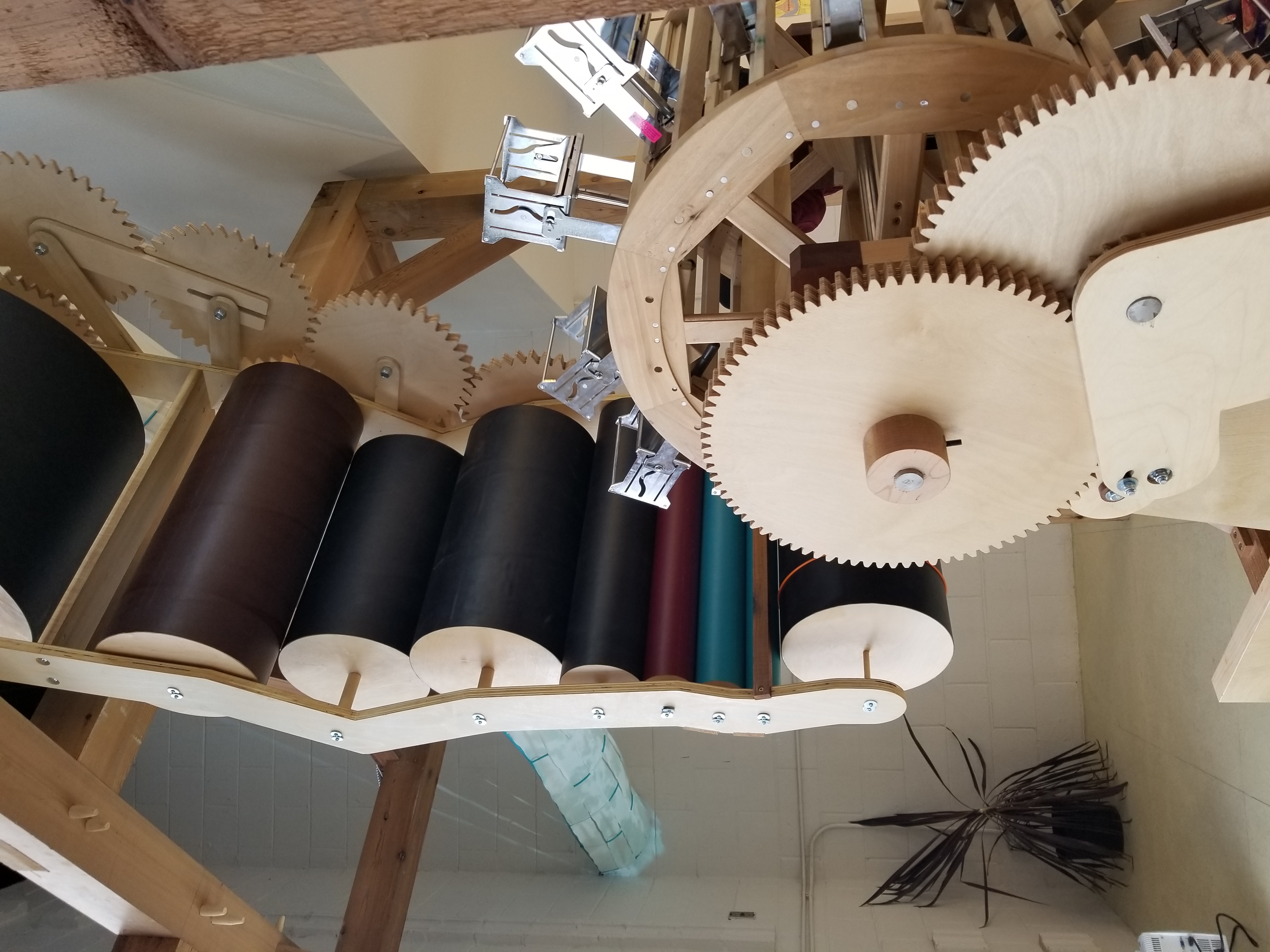
The Paper Machine (photos by: David Benedetto)
NolaVie: Chris, I’d love for you to tell me a little bit about this— I see on your website it’s called the “kinetic sculptural print machine.”
Christopher Deris: Yes. Well it’s a large installation, Rube Goldberg sculpture that has these references to the city with the flowing water. I started design-thinking about this sort of dynamic spectacle where we sort of consume the space; as the people came into the space they would be sort of surrounded by this machine.
And so you have flowing water that turns a huge waterwheel that powers a pillar of rollers that starts the press working, which is a big carriage that carries these self-inking stamps that press these images that were created by Amanda Cassingham-Bardwell. And then there’s a motion activated column of flying books that as you walk past and up the stairs, get activated and they fly around you. Then you can see that they take the whole space and go all the way up to about seventeen feet— trying to push those limits to where it sort of occupies that entire space.
NolaVie: How long did it take you to conceptualize that and then execute it?
CD: It was a short time frame. Thinking of the concept and the drawings maybe took two or three days, and we really tried to get it as crazy as possible—while thinking about what we can actually do. And then when we found the space. And then through the process of designing it and the practical application of actually making it work, it evolved into what it was. All along the way little parts were designed [and] altered to fit.
NolaVie: Bob, to turn it back to you, I’m interested in how you initially got involved with Antenna and what drove you to be in that place?
BS: Yeah I actually originally got involved with Antenna as a volunteer for the annual Draw-A-Thon when I first moved here in 2010, and I just really fell in love with the spirit and everyone who’s involved in that organization. I’ve slowly gotten more responsibility, as I’ve as I’ve stayed with the organization. And in the last few years we’ve had the opportunity to develop a staff and really ramp up everything that we do and create some of some of the most exciting programs for me in the city and seeing those come to life.
I’m an artist first and foremost, but I also I feel like working in this sort of realm of art administration folds into my kitchen-sink-full-of-dirty-dishes-that-I-wash that is creativity. I don’t feel left out if I’m not able to make my work in the process of building Antenna—it really feels like one in the same with my creative practice.
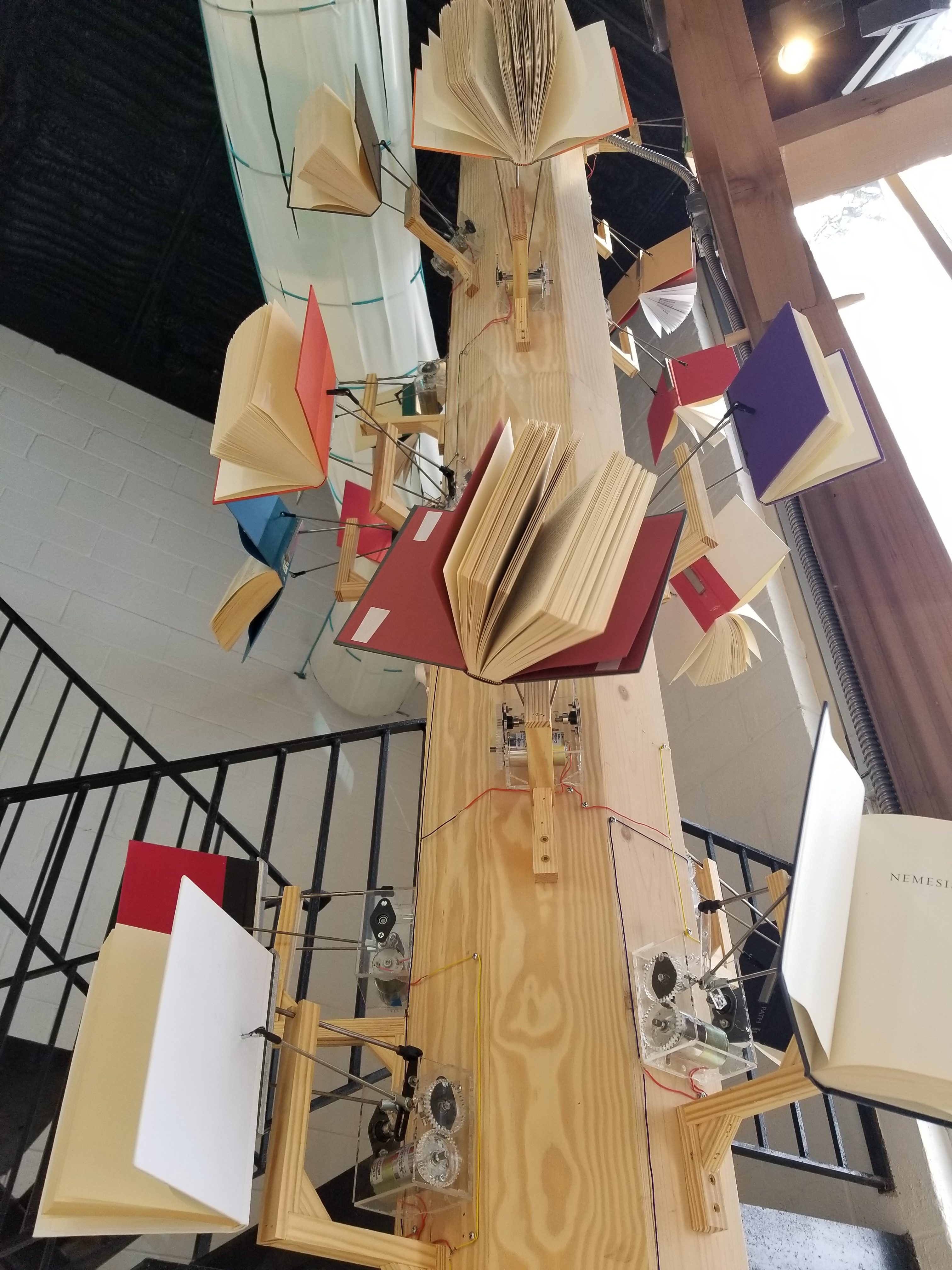
The flying book apparatus (photos by: David Benedetto)
NolaVie: And how would you describe your creative practice or your focuses?
I’m primarily a painter, but I also do a lot of sculpture. I actually just had a piece in the NOMA show [that] Arthur Rogers donated to NOMA— they purchased one of my sculptural pieces. That particular piece was based on my experience of just moving here and the Dollar Stores being our main kind of way of getting groceries in the Bywater. And so I started getting obsessed with all of the cardboard waste that was produced from those corporate Dollar Stores and created a one to one: taking all of the Dollar Store cardboard and recreating a Dollar Store out of that. So at some point you can see that project again; it’s called Family Dollar General Tree. It’s in the NOMA collection now so it can exist for generations. Or as long as the cardboard doesn’t get eaten by acid.
NolaVie: (Laughing) Yes— the longevity there!
BS: (Laughing) Yeah, exactly. It is definitely not archival.
NolaVie: Speaking of the archive— I was talking to you before Chris and you work at the Historic New Orleans Collection. What’s your role there?
CD: I’m an Associate Preparer at the collection.
NolaVie: And how long have you been over there?
CD: About two and a half years.
NolaVie: And I take it you like what you do?
CD: I do! It’s a great institution.
NolaVie: To move into your art itself a little bit— I’ve seen photos as well as videos that you have on YouTube and there’s this lovely play with the relationship between mechanical, automatic and [the] very human things within that. And I’m wondering why you hone in on that as your focus for your art?
CD: When I was in grad school, I was studying painting and then wanted something that interacted more with the audience. I took a toy class where we were making these wooden mechanical toys and then just sort of fell in love the material and the process. And it provided an opportunity to engage with the audience that I didn’t have with drawings or paintings. Most of— like you’re saying— most of my kinetic pieces have this humor where I’m trying to engage and get the audience to participate either with the machine, the space, or even maybe two audience members with each other in some sort of intimate act. And that led me into that kinetic realm.
NolaVie: This one is for both of you: I was wondering what’s the most affecting piece of art that you’ve seen this past year and why did it affect you?
BS: Oh, man. I really love thinking about some of the work that’s come out from Prospect. I really love the John Akomfrah for a piece that’s about [New Orleans jazz musician] Buddy Bolden at the Ogden Museum. It’s this really beautiful, poetic kind of ephemeral film that’s a 40-minute, epic three screen piece that is really incredible but also so simple and direct. There’s something about these pieces that they can get to a point really simply. That piece is really powerful in that way. Yeah. And then the new Star Wars.
CD: I have a three and a half year old and we don’t get out much to see art these days. We usually go to Oklahoma to visit family and then we’ll stop at in Fort Worth to see work there and see some of the museums. And I really like the Kimbell Museum, and I know there are pieces that I definitely was drawn to. It’s funny, I go to grad school for painting and that tends to be the one place where—even though I do a lot of sculptures—I’m always drawn to when I go to museums.
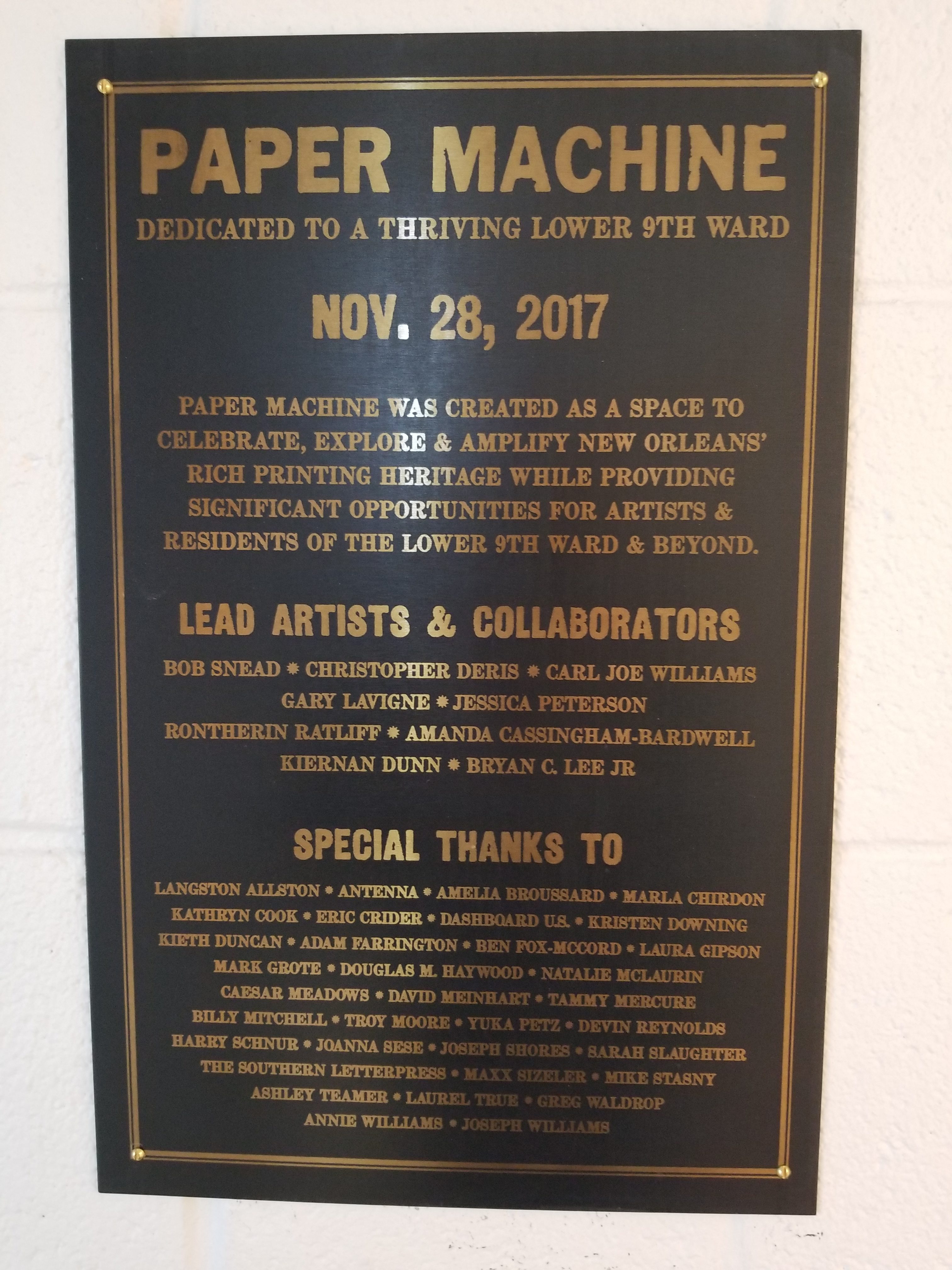
Paper Machine plaque (photos by: David Benedetto)
NolaVie: Bob, do you have any events that are going to be happening in the space coming up soon?
BS: Yes, so on January 24th Antenna is going to host its next iteration of Antenna: Signals at the Paper Machine. And for those of you don’t know what Signals is, it’s a “live action art magazine.” [That’s] how we frame it, and it floats around the city. So we get artists, writers, thinkers, [and] scientists all on a theme to do short presentations or performances on that theme for like 10 to 12 minutes, and then we also produce a physical print magazine from that event.
The one at Paper Machine is going to focus (of course) on papers. But really thinking about papers broadly like how they are both physical and psychological— thinking about immigration papers or Blue Books, pink slips, how paper could really affect one’s life generally. Life and love. Really thinking about how papers exist in everyday. We’re open now— we opened our doors earlier this month— but, that’s really going to be our grand opening celebration. And in addition to that we’ll have a slew of programming classes and workshops all based in print, just getting people really excited about different mediums that we can do there.
NolaVie: Before we wrap up, what do you both hope the public and the artistic community get out of the paper machine?
CD: I just hope they enjoy this sculpture–coming out and interacting with it and playing.
BS: Yeah for me as a as an Executive Director of an organization who’s rooted in the city, I really want people to develop projects there and get excited about the print processes that we’re able to produce in this beautiful space and ultimately drive a renaissance in print. That’s my goal with this space, and I think it’s possible. It’s a beautiful space to be in, and we have so many different kinds of techniques that you can do there: you can do letterpress, you can do silkscreen, [and] digital. There’s so much that can be done there, and I think people will take advantage of that, and I’m looking forward to it.
NolaVie: Well, to the renaissance then!
BS: (Laughing) Yes.
Antenna’s Signals Issue Number 7: Papers event will take place on Wednesday, January 24th. The event will start at 6PM and be located at Antenna’s Paper Machine Print Shop at 6330 St. Claude Avenue in the Lower Ninth Ward. More information can be found on Antenna’s website: www.antenna.works.
This interview has been shortened and edited for clarity.
 Waves of Change–The Impact of Political Tides on Louisiana’s Environmental Future
Healthy Gulf has been a cornerstone in safeguarding Louisiana’s natural and human resources through sustainable and equitable practices. But a new threat looms with Governor Jeff Landry’s recent consolidation proposal, which aims to merge crucial coastal management with the Department of Energy and Natural Resources. Writer Leah Claman delves into the complexities of this proposal, breaking it down for those unfamiliar with environmental policy, and sheds light on what this could mean for the future of Louisiana’s coast and its communities.
Waves of Change–The Impact of Political Tides on Louisiana’s Environmental Future
Healthy Gulf has been a cornerstone in safeguarding Louisiana’s natural and human resources through sustainable and equitable practices. But a new threat looms with Governor Jeff Landry’s recent consolidation proposal, which aims to merge crucial coastal management with the Department of Energy and Natural Resources. Writer Leah Claman delves into the complexities of this proposal, breaking it down for those unfamiliar with environmental policy, and sheds light on what this could mean for the future of Louisiana’s coast and its communities.
 Earthtalk: Retaining starts with repurposing – Green Light New Orleans
This piece spotlights Green Light New Orleans, a non-profit dedicated to promoting collective engagement in sustainability practices in local households. Author Brett Steinberg discusses the non-profit's Rain Barrel program, effectively combining art and water conservation.
Earthtalk: Retaining starts with repurposing – Green Light New Orleans
This piece spotlights Green Light New Orleans, a non-profit dedicated to promoting collective engagement in sustainability practices in local households. Author Brett Steinberg discusses the non-profit's Rain Barrel program, effectively combining art and water conservation.
